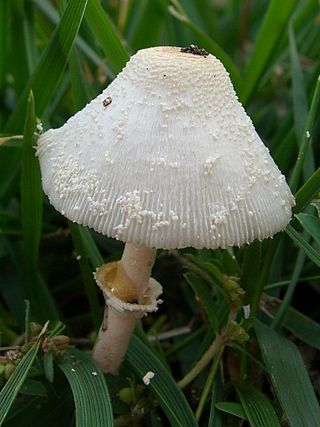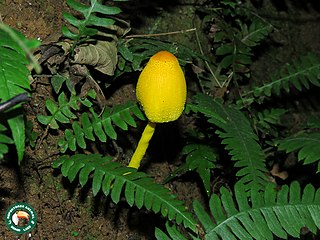
Leucocoprinus cepistipes, is a species of fungus in the family Agaricaceae. It is typically found on wood debris, such as wood chips but may also grow in potted plants or greenhouses. Typical characteristics include a fine-scaled bell-shaped cap, a partial veil, and a tendency to bruise a yellow to brown when handled.
Leucocoprinus straminellus is a species of mushroom producing fungus in the family Agaricaceae. Like other Leucocoprinus species it may have originated in a tropical climate but now finds a home in plant pots, greenhouses and compost piles in many countries. Leucocoprinus straminellus is described as being similar to the more commonly known Leucocoprinus birnbaumii but it is smaller and a lighter shade of yellow with smaller spores that lack a germ pore. It is also described as being superficially similar to Leucocoprinus fragilissimus but slightly more robust with flesh that is less translucent.
Leucocoprinus flavescens is a species of mushroom-producing fungus in the family Agaricaceae.

Leucocoprinus brunneoluteus is a species of mushroom producing fungus in the family Agaricaceae.
Leucocoprinus flavus is a species of mushroom producing fungus in the family Agaricaceae.
Leucocoprinus tricolor is a species of mushroom producing fungus in the family Agaricaceae.
Leucocoprinus medioflavus is a species of mushroom producing fungus in the family Agaricaceae.
Leucocoprinus acutoumbonatus is a species of mushroom producing fungus in the family Agaricaceae.
Leucocoprinus muticolor is a species of mushroom producing fungus in the family Agaricaceae.
Leucocoprinus elaeidis is a species of mushroom-producing producing fungus in the family Agaricaceae. In the local language, it is commonly known as elela.
Leucocoprinus viridiflavus is a species of mushroom producing fungus in the family Agaricaceae. It may also be known as Leucoagaricus viridiflavus.
Leucocoprinus viridiflavoides is a species of mushroom producing fungus in the family Agaricaceae. It may still be known as Leucoagaricus viridiflavoides.
Leucocoprinus bonianus is a species of mushroom producing fungus in the family Agaricaceae.
Leucocoprinus truncatus is a species of mushroom-producing fungus in the family Agaricaceae.

Leucoagaricus lacrymans is a species of mushroom producing fungus in the family Agaricaceae.
Leucocoprinus antillarum is a species of mushroom producing fungus in the family Agaricaceae.
Leucocoprinus microlepis is a species of mushroom producing fungus in the family Agaricaceae.
Leucocoprinus rhodolepis is a species of mushroom producing fungus in the family Agaricaceae.
Lepiota ochrospora is a species of mushroom producing fungus in the family Agaricaceae.
Leucoagaricus flavus is a species of mushroom-producing fungus in the family Agaricaceae.


